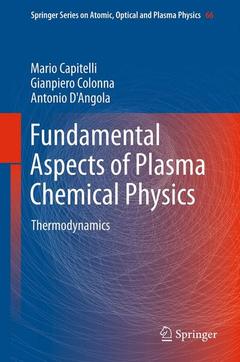Description
Fundamental Aspects of Plasma Chemical Physics, 2012
Thermodynamics
Springer Series on Atomic, Optical, and Plasma Physics Series, Vol. 66
Authors: Capitelli Mario, Colonna Gianpiero, D'Angola Antonio
Language: English
Subjects for Fundamental Aspects of Plasma Chemical Physics:
158.24 €
In Print (Delivery period: 15 days).
Add to cartPublication date: 11-2013
310 p. · 15.5x23.5 cm · Paperback
158.24 €
In Print (Delivery period: 15 days).
Add to cartPublication date: 10-2011
310 p. · 15.5x23.5 cm · Hardback
Description
/li>Contents
/li>Biography
/li>Comment
/li>
Fundamental Aspects of Plasma Chemical Physics - Thermodynamics develops basic and advanced concepts of plasma thermodynamics from both classical and statistical points of view.
After a refreshment of classical thermodynamics applied to the dissociation and ionization regimes, the book invites the reader to discover the role of electronic excitation in affecting the properties of plasmas, a topic often overlooked by the thermal plasma community.
Particular attention is devoted to the problem of the divergence of the partition function of atomic species and the state-to-state approach for calculating the partition function of diatomic and polyatomic molecules. The limit of ideal gas approximation is also discussed, by introducing Debye-Huckel and virial corrections.
Throughout the book, worked examples are given in order to clarify concepts and mathematical approaches.
This book is a first of a series of three books to be published by the authors on fundamental aspects of plasma chemical physics. The next books will discuss transport and kinetics.
Classical Thermodynamics.- Two and Three Level Systems.- Statistical Thermodynamics.- Atomic Partition Function.- Molecular Partition Function.- Real Effects: I. Debye-Hückel.- Real Effects: II. Virial Corrections.- Electronic Excitation.- Multi-Temperature Thermodynamics.- Thermodynamics of Planetary Plasmas.- Appendix.
Mario Capitelli, University of Bari, mario.capitelli@ba.imip.cnr.it
Gianpiero Colonna, IMIP CNR Bari,
These books may interest you

Plasma Physics and Engineering 184.47 €



